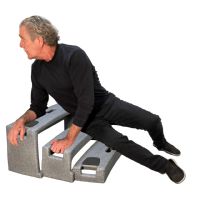 Written by Hulet Smith
Written by Hulet Smith
As an occupational therapist specializing in safe patient handling, I've had extensive experience working with various patient floor lifts across different healthcare settings. With falls affecting one in four Americans over 65 annually (1), selecting the right patient floor lift is crucial for both patient safety and caregiver wellbeing. Today, I'll share my hands-on analysis of five leading patient floor lifts, focusing on their practical applications in both clinical and home settings.
The Mangar Camel stands out as a versatile inflatable human lift with impressive capabilities. With a 705-pound weight capacity, it significantly exceeds most competitors' limits, making it particularly valuable for bariatric patients.
 | Mangar Camel Lift Inflatable Patient Lifter View Product |
The Camel's sequential inflation system allows for controlled lifting, which I've found particularly beneficial for patients with orthostatic hypotension. The splashproof rating (IP51) provides added versatility for wet environments.
The two-hour charge recovery time for a single lift could be limiting in high-traffic facilities. However, the dignified lifting process and minimal space requirements make it an excellent choice for home care settings.
The American-made IndeeLift offers a different approach with its mechanical lifting mechanism. Supporting up to 400 pounds, it provides a more structured lifting experience.
 | IndeeLift Human Floor Lift for Fall Recovery View Product |
The 65-pound unit weight requires consideration for transport. However, its ramped front design facilitates easier patient positioning, which I've found particularly valuable for patients with limited mobility.
This inflatable system offers a balanced approach to patient lifting with its three-stage inflation process.
 | Patient Lifting Cushion with Airlift Technology - HelpUp by Mobile Patient Lift View Product |
The 300-pound weight capacity might limit bariatric applications. However, the integrated headrest and slip-resistant materials enhance patient comfort and safety during transfers.
The ResQUp offers a unique non-powered approach to fall recovery, developed by a Doctor of Physical Therapy.
 | ResQUp Fall Recovery Device View Product |
While the 350-pound capacity is impressive for a non-powered device, it requires adequate upper body strength from users. Its versatility in allowing different recovery methods aligns well with varying patient capabilities.
The GoRise LT combines portability with robust features for clinical applications.
 | Portable Patient Floor Lift with 330 lbs. Lifting Capacity for Seated Floor Transfers from SuperHandy View Product |
The 330-pound weight capacity places it mid-range among competitors. However, its aluminum and steel construction provides excellent stability during transfers.
Recent research in the Journal of Healthcare Safety (2) emphasizes the importance of proper lifting equipment in preventing healthcare worker injuries. The American Nurses Association guidelines (3) recommend using mechanical lift devices whenever possible to reduce injury risk.
The Mangar Camel and IndeeLift offer the best combination of durability and weight capacity for varied patient populations.
The ResQUp and HelpUp provide excellent solutions for independent users with adequate strength and mobility.
The Mangar Camel's superior weight capacity makes it the clear choice for bariatric applications.
Each of these patient floor lifts offers unique advantages for specific care scenarios. The choice between an inflatable human lift and a mechanical system should be based on factors including:

Co-founder/CEO of Rehabmart, Pediatric Occupational Therapist, husband, and father. Passionate about connecting special needs kids with superb nutrition, sensory integration, and complementary health strategies. Excited about Rehabmart's mission to become the premier online educational platform which empowers caregivers by spotlighting innovative devices and interventions to achieve optimal patient response and recovery.